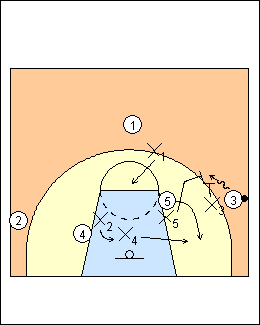 | 1 Avery Johnson An attacking man-to-man defence will wear down your opponent, disrupt their timing, and turn up your own aggressiveness. The most important thing in halfcourt defence is containing penetration. Close out with hands up on arrival, hands out on penetration (guard with your chest), he loves active hands and deflections, but no reaching, it throws you off balance. Out front is the contain area, don't force the dribbler, just do the best job you can to contain him. Deny one pass away. Don't help (suck in) from the corner, stay home, but may bluff and recover. Trap baseline penetration, hands up on arrival. There is a "v-back" by X3 to take 5 and X4 is the safety on the foul line. |
 | 2 A pass out of the trap to 4 is easy, all defenders recover to their own. On a skip pass to 3, X4 or X3 will take the ball, whoever is closer. If X4 takes 3, X1 takes 4 (shown); if X3 takes 3 (bad spacing), all recover to their own. Closing out when the ball is at or below the foul line, you can't let the ball go middle, force baseline into another wall. |
 | 3 Ballscreens Pick and roll defence should be consistent with the close-out. If the closeout is high-side, forcing baseline, then force the pick and roll baseline, trap, and rotate to leave open the attacker in the far corner. X1 takes screener 5. X1 and X2 are interceptors, X4 is the safety. No middle does not mean allow baseline. |
 | 4 If the closeout is low, forcing middle, xscreener X5 jumps in front of 5 to trap without waiting for the screen. Low X4 rotates to pick up the screener. X1 and X4 are interceptors, X2 is the safety. X3 bodies up to 3, hands out, don't get caught on the screen. |
 | 5 Post-ups Defend in a 3/4 position at worst, face on face. Trap from the nail (deny defender X1) on air time, X2 rotates up from the weakside, X3 denies a return pass. |
 | 6 If the ball is passed out of the trap to 1 then 2, there is a full rotation as X2 takes 1, X4 takes 2, and X1 fronts 4 (smaller players front when rotating to a big). Trapper X1 always goes opposite the pass out of the trap, takes the open man. Emphasize close-outs with all players, including the bigs, just as you emphasize rebounding by all players, not just the bigs. |
 | 7 If trapping on air time and a big defender is near a small nail defender (4 is high post or swing position), then X4 traps, which is more effective at stopping the ball and easier to match up on the pass out since most of the time 4 will dive on the double team. X4 and X1 must talk. Some coaches assign a trapper, it hasn't worked for the Mavericks, the "non-shooter" he guards has a career game. |
 | 8 911 situation Defending a hot player who can't be guarded one-on-one, if he gets the ball trap on air time with the defender of the passer, rotate, then his defender denies a return pass on a pass out of the trap. Defensive rebounding - just hit someone in your vicinity (check off), turn, and try to get the ball. You may have to face guard certain guys to make sure they don't get the rebound. |
This page was made with Basketball playbook from Jes-Soft